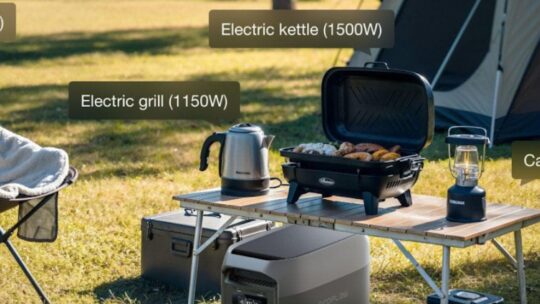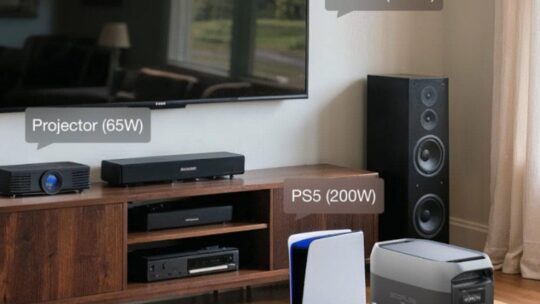
A portable power station can be a game-changer for outdoor adventures or home emergencies—but only if you choose wisely. Many buyers overlook crucial details that affect performance, safety, and long-term value. Here are the five most common mistakes people make when buying one—and how to avoid them.
1. Confusing Capacity with Usable Power
The first mistake is assuming that a higher capacity automatically means more usable energy. Most brands advertise battery capacity in watt-hours (Wh) or amp-hours (Ah), but not all of that energy is available for your devices. A portable power station loses about 10–20% of its stored power during conversion from DC to AC.
For example, a model rated at 1,000 Wh might actually deliver around 800 Wh in real-world use. That’s still impressive, but it’s important to understand what those numbers mean before you rely on it for long outages or road trips.
Tip: Estimate your actual power needs. Add up the wattage of your essential devices—phone (10 W), laptop (60 W), mini fridge (90 W)—and multiply by the number of hours you plan to run them. Then choose a portable power station that exceeds that total by at least 20–30%.
This simple calculation helps you avoid disappointment when you realize your “large” power station can’t actually last through the night.
2. Ignoring Output Ratings and Device Compatibility
Not all outlets are created equal. Many first-time buyers focus on how big the battery is, not how much power it can output at once. If a portable power station can’t deliver enough watts for your devices, you’ll either get slow performance—or nothing at all.
For instance, a coffee maker or hair dryer can easily require 1,200–1,500 W, while many mid-range power stations only handle 600–800 W. Laptops, CPAP machines, or induction cookers also need consistent output, not just short bursts of peak power.
Tip: Always check both “continuous” and “surge” power ratings. Continuous power is what the station can handle steadily, while surge covers short spikes during startup. For home backup or van living, choose at least 1,000–2,000 W continuous output.
Equally important: make sure your portable power station has the right ports—USB-C PD for laptops, AC outlets for appliances, and 12 V DC for car devices. Compatibility ensures you can plug and play without extra adapters.
3. Overlooking Charging Speed and Recharging Options
The third mistake is forgetting that charging works both ways. People often focus on how fast a portable power station can charge their devices—but neglect how fast the station itself recharges.
Imagine you’re preparing for a camping trip or a power outage. You plug in your power station the night before, only to discover it’s still half-charged in the morning. Many models take 6–8 hours to recharge unless they support fast-charging input.
Tip: Look for AC input above 500 W for quick recharging. High-end stations can go from 0–80% in about an hour. Solar recharging is another great option—especially if you live off-grid or experience frequent outages. Make sure the unit supports high solar input (400–800 W) and MPPT technology for better efficiency.
The best portable power stations let you charge via wall outlet, car, or solar panels—all at the same time. That versatility can make the difference between a full charge and frustration when you need power the most.
4. Focusing on Price Instead of Build Quality and Safety
It’s tempting to buy the cheapest option, especially when capacities look similar on paper. But internal components—battery cells, inverter design, and cooling systems—vary widely in quality. Cheaper models may skip over key safety features like short-circuit protection, temperature control, and certified battery management systems.
A poor-quality portable power station can overheat, degrade quickly, or even fail completely after a few months. Some use low-grade lithium-ion cells that lose capacity fast or struggle in cold weather.
Tip: Choose brands that use LiFePO₄ (lithium iron phosphate) batteries. They last longer—often 3,000+ charge cycles—and are much safer under high temperatures or heavy use. Look for certifications such as UL, CE, or FCC, and check for warranties of at least 2–5 years.
In short, it’s better to invest once in a reliable, well-built portable power station than to replace a cheap one after every season.
5. Ignoring Portability, Noise, and Real-World Usability
The last mistake? Forgetting why it’s called a portable power station. A model might boast impressive numbers but weigh over 60 pounds—great for a garage, terrible for travel. Portability matters, especially if you’ll carry it between home, car, and campsite.
Pay attention to size, weight, and noise level. Some models use active cooling fans that can be surprisingly loud, while others are whisper-quiet. If you plan to use your portable power station in a tent, RV, or small apartment, noise can make a big difference in comfort.
Tip:
- Under 20 lbs: Ideal for camping and short trips.
- 20–40 lbs: Balanced for van life or light home backup.
- 40 lbs+: Designed for extended home use or emergencies.
Also check the display interface. A clear, real-time screen showing input/output wattage and remaining time can make operation much easier. Usability isn’t a luxury—it’s part of what makes the product truly portable.
Bonus: Forgetting About Expandability
Many users only think about their current power needs. But as more devices join your setup—extra lights, coolers, or even power tools—your energy demand grows. Some portable power stations allow battery expansion, letting you add modules for higher capacity.

If you expect to use it for years, expandable systems can save money in the long run. You won’t need to replace your entire setup—just add more capacity when needed.
Conclusion
Buying the right portable power station isn’t about chasing the biggest battery or the lowest price—it’s about matching features to your lifestyle. Think about how you’ll use it, what you’ll power, and where you’ll take it.
By avoiding these common mistakes, you’ll find a portable power station that delivers reliable energy—whether it’s for camping, work, or peace of mind when the lights go out.


















